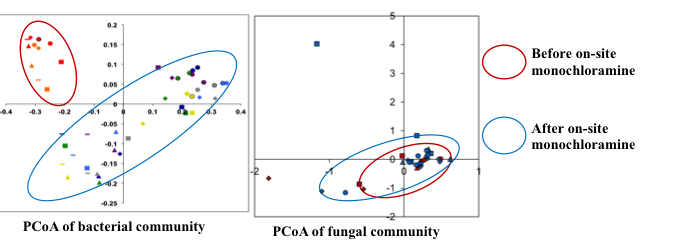The environmental engineering research community now recognizes that it is important to understand the bacterial ecology of premise (building) plumbing systems to control opportunistic pathogens (OP). Many investigations, including those supported by the Sloan Foundation MoBE program, have begun to shed light on the factors driving bacterial ecology in drinking water systems. While the bacterial ecology story is far from complete, the ecology of microbial eukaryotes is even less well understood. Microbial eukaryotes are important members of premise plumbing microbial ecology, both for their influence on bacterial ecology and as OP. Some free-living amoeba (FLA), such as Acanthamoeba, are OP. FLA also control biofilms through bacterial grazing, and may protect bacterial OP, such as Legionella and Mycobacterium, from disinfection. In fact, bacterial OP infecting FLA are known to be more virulent than they would otherwise be. Additionally, fungi may be relevant OP in the water system, especially for immune-compromised persons.
These points take on greater importance in light of the proposed ASHRAE standard 188p for control of legionellosis. In all likelihood, the final version of this standard will recommend on-site disinfection for control of Legionella spp. This topic is of concern to property owners due to liability for infections caused by the drinking water system. It is rare for facilities to design or operate disinfection systems to control more than Legionella or some other indicator bacteria, but these same facilities operate under the assumption that because they are utilizing secondary disinfection, their premise plumbing is “safe” from all and any microbial threats. A much more elegant approach, as put forth by Dr. Amy Pruden, would be to design and operate the system in a ‘probiotic’ way such that a more desirable microbial ecology is naturally selected and outcompetes OP. A probiotic approach would require an understanding of all microbial ecology drivers, including microbial eukaryotes.
In our recent paper published in Water Research, we examined the fungal ecology of samples that were previously analyzed for bacterial ecology. These samples were from a hospital hot water system both before and after the installation and operation of an on-site monochloramine disinfection system. As shown in the attached figure, we saw an immediately detectable shift in the bacterial community, but no discernable shift in the fungal community, after the introduction of on-site monochloramine. The apparent fungal diversity of the system was also low, with only five core genera; however, there were a high diversity of fungi ‘passing-through’, likely from the surface water being treated and an inability to discern viable fungal cells.
To me, this work raises questions about not only fungal ecology in premise plumbing systems, but microbial eukaryotes in general. What are the factors driving the abundance and diversity of microbial eukaryotes? If our overall goal is to control premise plumbing OP, should we be targeting microbial eukaryotes as a ‘keystone species’? What is the interplay between microbial eukaryotes and the overall microbial ecology — not just OP? As we have often heard throughout the Sloan MoBE program, gaining a comprehensive view of the microbial ecology of the built environment will require a holistic view, and in the case of premise plumbing, must include microbial eukaryotes.
Ma, X.; Baron, J. L.; Vikram, A.; Stout, J. E.; Bibby, K., Fungal Diversity and Presence of Potentially Pathogenic Fungi in a Hospital Hot Water System Treated with On-Site Monochloramine. Water Research. doi:10.1016/j.watres.2014.12.052
Baron, J. L.; Vikram, A.; Duda, S.; Stout, J. E.; Bibby, K., Shift in the Microbial Ecology of a Hospital Hot Water System following the Introduction of an On-Site Monochloramine Disinfection System. PLoS ONE 2014, 9, (7), e102679.

UPDATE: Recent great paper on this topic co-authored by Jack Gilbert “Diverse protist grazers select for virulence-related traits in Legionella”
http://www.nature.com/ismej/journal/vaop/ncurrent/pdf/ismej2014248a.pdf
Kyle,
My personal premise has been “kill-’em-all”. In this manner there is no concern for microbiome shift or concern for other exploitation of the ecological niche being created by lesser disinfection attempts. I have expressed this position to Amy previously.
Regards, DTRT-PBP
Michael